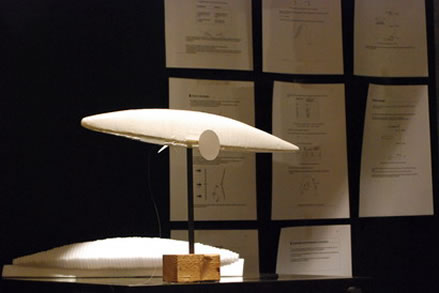
Can you explain how the airship would work?Well, the ship would be equipped with two very large propellers. It uses these for propulsion, just like regular rotors, but when it runs out of fuel, it does not land. The overall result is an airship that is not very fast, but is extremely autonomous. It can regenerate its own fuel and lift gas from wind and water and as such is a true zero-emission vehicle, on par with a sailing ship. Isn't hydrogen what was used in the old zeppelins? As in the Hindenburg disaster? Why would you want to use that?Yes, hydrogen is what was used inside the Hindenburg. In 1937 that airship went down in flames and since then all airships have been filled with non-combustible helium. When you burn hydrogen in an engine, the only emission is water vapor. Because of this, hydrogen is a fantastic energy source. From all the possible solutions for energy storage, this one is the most radical, the most elegant and the most beautiful solution. Hydrogen is what we need to make alternative energy sources, like wind and solar, more flexible. What we want to do is store solar power for a cloudy day, and today we can’t do that in a scalable way. Ok, we have batteries, you can run a house on those. But they’re limited in size, you; can’t run a village on battery power, never mind a city. With hydrogen you can do that. And we have the technology. BMW has a hydrogen car parked in Brussels. Only, you can’t use this car in any practical way as long as there are no hydrogen refueling stations all over Europe. These kinds of innovations, that need an entire new infrastructure for them to be useful, very seldom get realized. When you put hydrogen in a car, what you’re really saying is “It’s a clean fuel, it’s a replacement for gasoline.” And that’s wrong! I think that’s a big problem. It’s perfectly viable to introduce a new piece of technology as a high-end, expensive product. Over time it will get cheaper, it will get better, it will have a greater range in the future and be more efficient. Having it cost more and perform less for now is a legitimate compromise. But if you compromise the very story of clean power you’re trying to tell, if you distort the working principle behind it, I think you’re undermining your own product. That’s where this airship is a much better solution. Because; It would be a flagship for a clean hydrogen technology. A beast, 90 meter long, that needs to rest in order to restore its power levels. It’s free to roam the entire planet.
But how about safety?Look, today we have safe hydrogen cars. Why? Because we spent a lot of time testing and improving them. Same for safe hydrogen planes and ships. If we don’t have safe hydrogen airships then that’s foremost because nobody has tried to develop them. All ideas on hydrogen airships, even those in authorative publications, are anecdotal or based on observations dating back to before WWII, and it’s a very misguided discussion. I haven’t been able to find any publications on systematic tests with hydrogen balloons of any substantial scale. Adisson Bain, a former NASA-engineer is one of the authorities on the Hindenburg disaster. His experiments were combustion tests on small pieces of cloth. But you can’t rescale combustion tests! A match doesn’t burn the same way a forest does! But the only sensible way to discuss safety is by doing physical, documented experiments and inviting other people to repeat and confirm them.
What's wrong with current airships?The shape, for starters. That typical cigar-shape is aerodynamically the most efficient shape. It’s the shape you want, if you want to make the airship go as fast as possible, but it is also a very complex and expensive shape to build. Making a fast airship was a good idea 80 years ago, when these things were the best things in the air. Today they are slower than helicopters. Even if they try very hard they are inherently slow. I believe that for a good design, you need to optimize the strengths of a concept, not try to compensate for its weaknesses. Accept its shortcomings; an airship will always be slower than an airplane and less maneuverable than a helicopter. So forget speed, what you need to do is identify what’s unique to the zeppelin.
What would that starting point be? What can't you do in a helicopter?Step outside and have a cup of coffee… Huh?A number of companies are using their airships for panoramic tours. Only, they put the passengers inside a small cabin under the belly of the ship. That’s a good place when you’re the pilot and you want to land, but a really silly place to enjoy the trip. An airship offers you a lot more space. The only requirement is that you need to keep the weight down. So put a loft inside, with 2 panoramic windows! Add a terrace, with sliding doors so you can step outside. Turn of the engines, and you convert the ship into a balloon. There will be no wind, and the clouds will be below you. An airship will never be a good motor boat, but it can be a perfect sailing yacht. If we love sailing, it’s not because of the speed, it’s because of its elegance. And you don’t steer it from inside, you stand on the deck to feel the wind and the sun on your face. So design it to maximize the flight experience. Make it about the journey, not about arriving on time. Wear a scarf and pilot the thing like riding the back of the whale!
So you intend to design a luxury flying yacht?Well, if it was only that, it would be quite boring. But there’s another side to this comparison with sailing. Again, design a concept from its strengths. An airship can stay in the air for as long as it likes without using fuel. Translate this into endurance: translate it into autonomy. Design an airship that can use the wind, instead of fight it. Make it independent. Keep it airborne. Give it a clean, self-sustaining power source. Take it around the world.
|
|
![]()
If you wish to be informed on the progress into the project, upcoming exhibitions or events, you can subscribe to the newsletter here. The newsletter is sent 4 to 8 times a year. No newsletter will be sent without the option to unsubscribe.
This link will compose an email with the subject "newsletter subscription'. It can be sent blanc.
Alternatively you can manually send an email to inschrijving@aeromodeller2.be with the subject 'newsletter subscription'.
| newsletter subscription |
|
![]()
Interviews on other sites:

